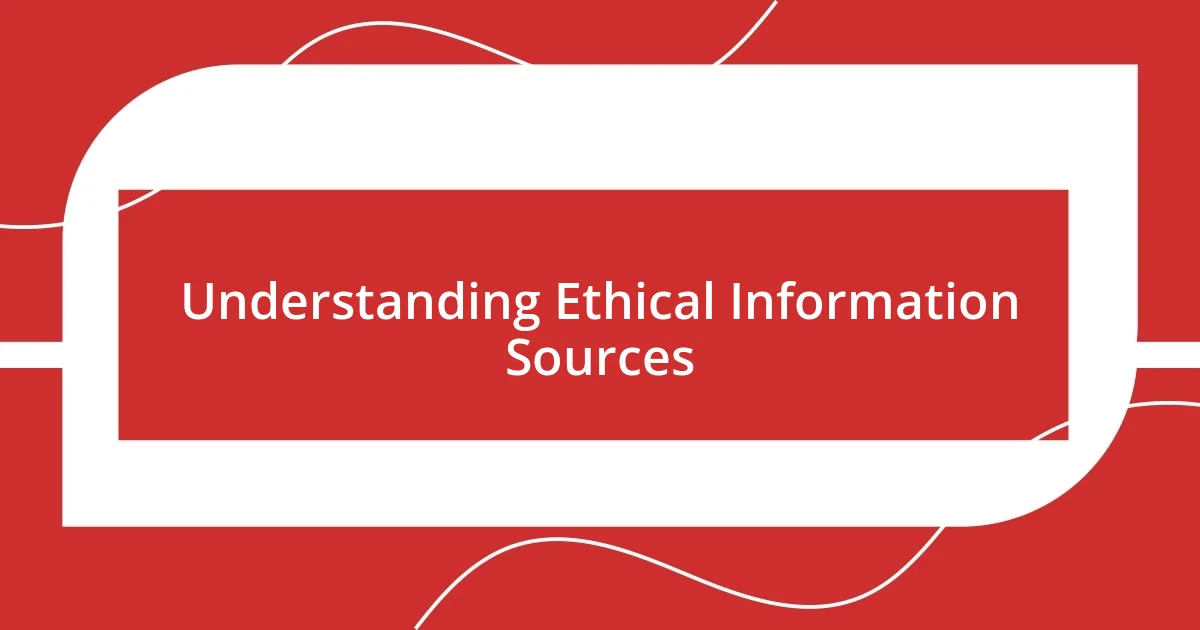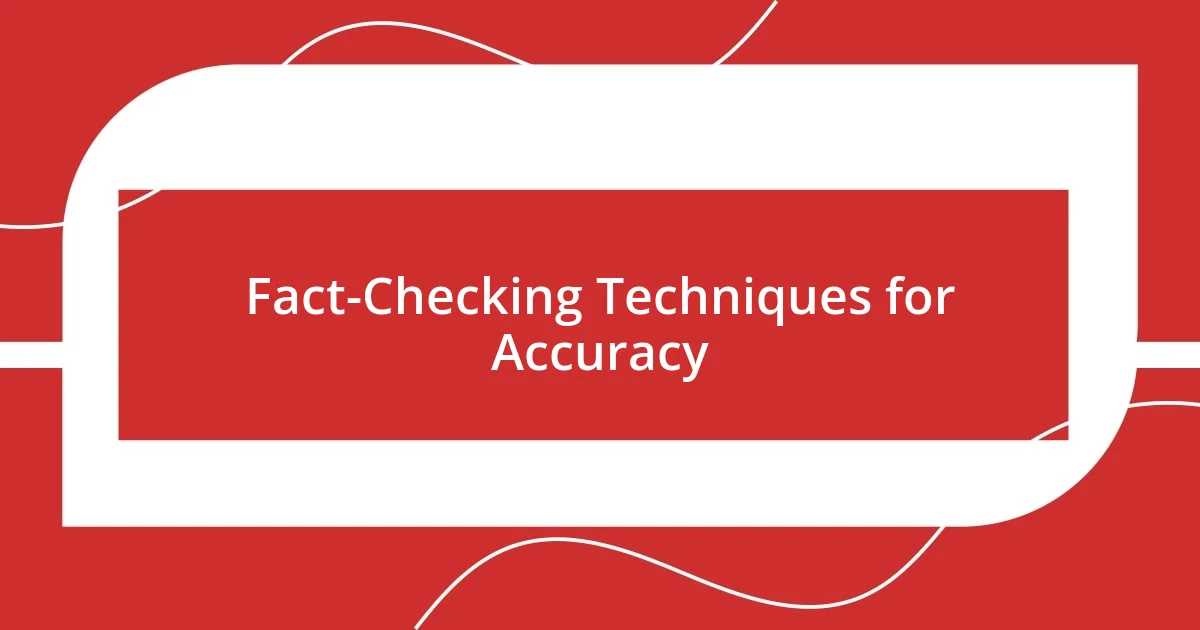Key takeaways:
- Assess the credibility of information sources by checking author credentials, transparency in research, and ownership influences.
- Utilize systematic fact-checking techniques, such as consulting reputable websites and seeking primary sources, to verify claims before forming opinions.
- Cultivate diverse perspectives and maintain awareness of personal biases to enhance critical thinking and foster deeper understanding in discussions.

Understanding Ethical Information Sources
When seeking ethical information sources, it’s essential to consider the credibility of the creators behind the content. I often ask myself, who wrote this? Understanding the author’s background, expertise, and potential biases can reveal a lot about the information’s reliability. For instance, I once stumbled upon an article that made sweeping claims about a health topic. After a quick review of the author’s credentials, I found they had no formal education in the field, which made me question the accuracy of their statements.
I also pay attention to whether sources are transparent about their research methods and funding. One time, I encountered a study boasting miraculous results on a popular supplement, yet the funding was provided by the supplement’s manufacturer. This raised immediate red flags for me. As I sift through information, I remind myself that ethical sources will typically disclose potential conflicts of interest, making it easier to trust what I’m reading.
When I consume information, I consider how it aligns with established research and multiple perspectives. It’s eye-opening to see how different viewpoints can enrich my understanding. Have you ever read conflicting reports on a single issue? I find that by comparing various ethical sources, I can create a well-rounded view, avoiding the pitfalls of misinformation that often plague our digital landscape.

Identifying Reliable News Outlets
Identifying reliable news outlets involves a careful evaluation of their content, intentions, and the transparency of their reporting. I often find myself vetting sources like I would friends—what’s their track record? Recently, I came across a viral news story that seemed sensational. I looked into the outlet and discovered it had a history of exaggeration and incomplete facts. Understanding a publication’s reputation can save you from misinformation and help maintain a balanced perspective.
I’ve learned that considering news outlets’ ownership can offer insights into potential biases. For instance, I once followed a particular website that presented itself as independent; however, after some digging, I realized it was owned by a larger corporation with vested interests in certain industries. This realization shifted my approach to their reporting. Whenever I come across a new source, I take a moment to understand who’s behind it, which helps me assess the underlying motivations and reliability of the information presented.
To further aid in my discernment, I compare news outlets with one another. A favorite practice of mine involves cross-referencing the same story across different platforms to see how they report it. I recall reading about a major event and comparing three different newspapers. The contrasts in tone and details highlighted each outlet’s slant, enriching my understanding of the event’s complexities. So, training myself to look beyond the headlines has truly deepened my news-consuming experience.
| Criteria | Evaluation Tips |
|---|---|
| Author Credentials | Check the author’s background and qualifications. |
| Transparency | Look for disclosure about research methods and funding sources. |
| Ownership | Investigate who owns the news outlet for potential biases. |
| Cross-Referencing | Compare multiple outlets reporting on the same story. |

Fact-Checking Techniques for Accuracy
When it comes to fact-checking techniques, I’ve found that a systematic approach really helps in sifting through the noise. A while back, I stumbled upon a claim regarding a new scientific breakthrough that seemed too good to be true. Diving into the details, I used several fact-checking websites like Snopes and FactCheck.org, which not only provided a comprehensive breakdown of the claim’s validity but also offered context about previous similar assertions. This experience reinforced my commitment to verifying information before forming an opinion.
Here are some fact-checking techniques I rely on:
- Use reputable fact-checking websites: Platforms like Snopes, FactCheck.org, and PolitiFact can clarify claims with well-researched analyses.
- Look for primary sources: I try to trace back to original studies or documents to get the most accurate information.
- Check the publication date: Timeliness is crucial; outdated information can sometimes mislead our current understanding.
- Read beyond the headline: I’ve learned that headlines can distort the narrative, so I always dive deeper into the article for the full context.
- Seek out expert opinions: Consulting industry professionals often lends valuable insights, especially when the topic is complex or technical.
By weaving these techniques into my information-gathering habits, I feel more confident in my understanding of complex issues. I remember feeling overwhelmed by a viral meme claiming that a certain diet could cure chronic illnesses. Instead of being swept away by the enthusiasm, I paused and utilized my fact-checking toolkit, which ultimately led me to reliable studies debunking those claims. That moment taught me the importance of approaching sensational information with a critical eye and a bit of skepticism.

Evaluating Diverse Perspectives
When exploring diverse perspectives, I’ve often felt like a traveler navigating through a bustling marketplace of ideas. Each stall represents a different viewpoint, and it’s fascinating to see how personal experiences shape opinions. I once engaged in a heated online debate about climate change, which led me to dive into articles from various sides. Listening to arguments from both extreme proponents and skeptics broadened my understanding of the complexities involved. This taught me an important lesson: embracing diverse perspectives can reveal blind spots in my own thinking.
I recall a moment of clarity during a community discussion on immigration. Listening to a friend share their family’s journey opened my eyes to the emotional weight behind statistics and policies. It struck me that, often, we can get caught up in the numbers and forget the human stories behind them. I began asking questions like, “What personal experiences have shaped this viewpoint?” and “How can understanding someone else’s journey create empathy?” This practice of inquiry has enriched my conversations and allowed me to appreciate the depth of differing opinions.
Navigating diverse perspectives isn’t just about gathering differing opinions; it’s about cultivating a reflective mindset. For instance, after engaging with viewpoints opposite to mine, I often take a moment to assess my feelings and beliefs. Am I defensive or open-minded? Understanding my reactions has been a crucial step in my journey. I find that reflecting on how a perspective resonates—or clashes—with my values not only fosters personal growth but also creates a more respectful dialogue. It’s an ongoing process, but each interaction teaches me something new.

Maintaining Awareness of Bias
Maintaining an awareness of bias can be quite a journey, and I’ve learned that it’s something I must actively cultivate. One time, while reading a popular blog post, I noticed that the author only referenced studies that supported their position. It sparked a thought: how often do we unconsciously favor sources that echo our beliefs? This realization helped me appreciate the importance of seeking out a wider range of opinions and recognizing my own preferences in the process.
I vividly recall streaming a documentary that took a firm stance on social media and its effects on mental health. While it was compelling, I felt a twinge of discomfort knowing it leaned heavily on anecdotal evidence and cherry-picked statistics. This made me ask myself, “Am I being swayed by this narrative without considering other studies?” I decided to balance that perspective by looking into peer-reviewed articles on the topic. It was eye-opening to see how data could paint a vastly different picture, reminding me that bias can lurk even in well-produced content.
Sometimes, I find it helpful to keep a bias journal. After diving into a hot-button topic, I jot down my initial thoughts and feelings. Reflecting on why I reacted a certain way often reveals underlying biases I didn’t recognize at first. For instance, when I read about economic policies, I noticed an automatic defense response rooted in my upbringing. By acknowledging these biases, I can approach new information more thoughtfully. I wonder, how many of us take the time to unravel those threads? It’s a continuous process, but each moment of reflection fuels my journey toward more ethical consumption of information.

Practicing Critical Thinking Skills
Practicing critical thinking is a bit like flexing a muscle; the more I do it, the stronger it becomes. Just the other day, while scrolling through my social media feed, I came across a startling claim about a new health trend. Instead of just hitting “like” or sharing it, I paused and asked myself, “What evidence supports this? Who made this claim?” This simple act of questioning transformed my scrolling into an active search for legitimate sources, and I felt empowered by my own inclination to dig deeper.
Sometimes, I find myself in discussions where opinions clash dramatically, and I can feel the tension rising. I remember a spirited conversation I had about economic inequality, where emotions were high, and frustration bubbled beneath the surface. Instead of taking offense, I chose to focus on understanding the underlying assumptions each person brought to the table. Asking questions like, “What led you to that conclusion?” helped me uncover valuable context. I realized that every opinion is often rooted in unique experiences and beliefs, which made the exchange not just a debate but a learning opportunity.
It’s interesting to consider how often we engage with information without fully processing it. In my own experience, I’ve noticed that when I let my guard down and admit I’m unsure about something, it opens the door to critical thinking. For instance, while exploring a new philosophical text, I struggled to grasp certain concepts. Instead of shying away, I reached out to peers for their interpretations. This created a rich dialogue where I could ask questions and expose gaps in my understanding—turning confusion into a fertile ground for growth. How often do we allow ourselves that vulnerability? Embracing it can lead to a deeper comprehension and more fruitful conversations.

Developing a Sustainable Information Habit
Developing a sustainable information habit requires intentionality. I remember a time when I realized my reading habits were chaotic; I would jump from one trendy article to another without any structure. Establishing a routine, perhaps dedicating just 15 minutes each morning to sift through trustworthy sources, transformed my approach. Now, each day begins with a sense of purpose, as I uncover well-researched insights tailored to my interests. What if more of us embraced this kind of daily discipline?
As I strive for balance, I’ve found that diversifying my sources is crucial. For instance, when exploring environmental issues, I intentionally seek out perspectives from science journals, grassroots organizations, and even opposing viewpoints. This practice not only enriches my understanding, but it also teaches me to appreciate the nuances of complex topics. Have you ever noticed how varied narratives can lead to a more rounded view? I often reflect on how learning from contrasting viewpoints helps me cultivate empathy and a deeper understanding.
Developing a sustainable information habit also means recognizing when to step back. I recall a specific week when the news became overwhelming—each headline pulling me deeper into anxiety. Taking a conscious break and switching my focus to lighthearted books and podcasts helped me regain perspective. It raises the question: how often do we check in with our emotional responses to information? A moment of pause can lead to clearer thinking and a healthier relationship with the news we consume.















